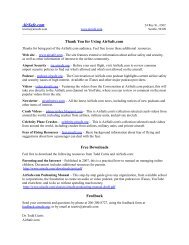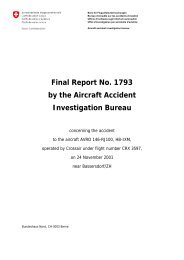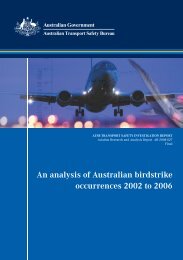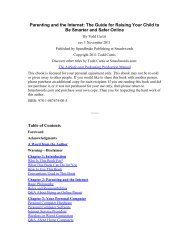AAIB Investigation Updates (PDF) - Airline Safety and Security ...
AAIB Investigation Updates (PDF) - Airline Safety and Security ...
AAIB Investigation Updates (PDF) - Airline Safety and Security ...
Create successful ePaper yourself
Turn your PDF publications into a flip-book with our unique Google optimized e-Paper software.
<strong>AAIB</strong> Interim Report G-YMMM EW/C2008/01/01<br />
Water ice in fuel<br />
As the fuel temperature reduces to around ‐1°C to<br />
‐3°C (31 to 27°F), entrained water in the fuel will<br />
start to freeze <strong>and</strong> form ice crystals. The density of<br />
the ice crystals is approximately the same as the fuel,<br />
so the crystals will generally stay in suspension <strong>and</strong><br />
drift within the fuel. As the fuel temperature is further<br />
reduced, it reaches the Critical Icing Temperature, which<br />
is the temperature at which the ice crystals will start to<br />
stick to their surroundings. When the fuel temperature<br />
reduces to approximately ‐18°C (0°F), the ice crystals<br />
adhere to each other <strong>and</strong> become larger. Below this<br />
temperature little is known about the properties of ice<br />
crystals in fuel <strong>and</strong> further research may be required to<br />
enable the aviation industry to more fully underst<strong>and</strong><br />
this behaviour.<br />
Fuel System Icing Inhibitor<br />
Fuel System Icing Inhibitor (FSII) is a fuel additive<br />
that, when used in concentrations of 0.10% to 0.15% by<br />
volume, can prevent the formation of water ice down to<br />
a temperature of ‐40°C (‐40°F). FSII is only effective<br />
on undissolved water (entrained <strong>and</strong> free) <strong>and</strong>, as it is<br />
approximately 500 times more soluble in water than<br />
fuel, it will migrate into the undissolved water <strong>and</strong> lower<br />
its freezing point. The mixture of water <strong>and</strong> FSII has a<br />
similar density to water <strong>and</strong> will be either consumed by<br />
the engines or can be removed from the fuel tank sumps<br />
during normal sumping operations.<br />
FSII is not commonly used in large public transport<br />
aircraft <strong>and</strong> was not detected in the fuel samples taken<br />
from G-YMMM. However, aviation turbine fuel<br />
containing FSII has been used on aircraft flown by<br />
the Royal Air Force, US Air Force <strong>and</strong> other military<br />
forces for about 50 years. The additive was introduced<br />
following accidents on the Boeing B‐52 aircraft when<br />
© Crown copyright 2008<br />
12<br />
engine fuel filter icing led to restricted fuel flow <strong>and</strong><br />
subsequent engine rollbacks 4 <strong>and</strong> flame outs. FSII is<br />
also in use as an alternative to fuel heaters on many<br />
small civilian jet aircraft. The additive is approved<br />
for use on the Boeing 777 <strong>and</strong> the FAA has provided<br />
information on its use in aircraft through Advisory<br />
Circular 20‐29B.<br />
Estimated water content of the fuel<br />
It is estimated that the fuel loaded at Beijing would<br />
have contained up to 3 ltr (40 parts per million (ppm))<br />
of dissolved water <strong>and</strong> a maximum of 2 ltr (30 ppm)<br />
of undissolved water (entrained or free). In addition, it<br />
is estimated that a maximum of 0.14 ltr of water could<br />
have been drawn in through the fuel tank vent system<br />
during the flight to Heathrow. This water would have<br />
been evenly spread throughout the fuel <strong>and</strong> would have<br />
been in addition to any water remaining in the fuel<br />
system from previous flights. These quantities of water<br />
are considered normal for aviation turbine fuel.<br />
Tests for the presence of water in the fuel<br />
It was not possible to establish the condition of the fuel<br />
in the centre tank at the time of the accident as it had<br />
subsequently been grossly contaminated with fire fighting<br />
foam <strong>and</strong> water applied by the fire crews immediately<br />
following the accident.<br />
A requirement in the fuel specification is that the fuel<br />
should be visually inspected to ensure that it is clear,<br />
bright <strong>and</strong> free of water <strong>and</strong> sediment. In addition to<br />
the appearance test, the Karl Fischer test, which uses a<br />
chemical method to establish the total amount of water<br />
(dissolved <strong>and</strong> entrained) in the fuel, was carried out on<br />
fuel samples taken from the left main tank sump, the APU<br />
fuel line <strong>and</strong> the right engine variable stator vanes.<br />
Footnote<br />
4<br />
Rollback - uncomm<strong>and</strong>ed reduction of engine thrust











